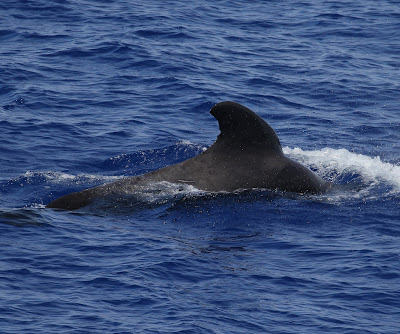There was one final highlight of the last day before we reached St Helena: a late morning sighting of our first Short-finned Pilot Whales for the Odyssey. As generally happened when we saw either Pilot Whale species, we first saw our them well ahead of the Plancius. Consequently, there was plenty of time to announce to the passengers that the Plancius was going to stop for around 30 minutes to allow everybody to see & enjoy them. The great things about both species of Pilot Whales is they usually feed in extended parties & they spend good periods of time on the surface. Additionally, they were not spooked by the Plancius & if the ship was stopped, it could then slowly manoeuvre close to the Pilot Whales to allow us good views without causing them concern. The amount of time they were happy to spend close to the Plancius made me confident that this slow approach wasn't worrying them.
Short-finned Pilot Whale: The long, low, curved-backed dorsal fin looks good for a male Short-finned Pilot Whale
Short-finned Pilot Whale: Seeing this distinctive dorsal fin shape of the male on the left, confirms you are looking at a Pilot Whale & based upon range this will be a Short-finned Pilot Whale
Short-finned Pilot Whale: Seeing this distinctive dorsal fin shape of the male on the left, confirms you are looking at a Pilot Whale & based upon range this will be a Short-finned Pilot Whale
Short-finned Pilot Whale: This male is blowing, but the blow isn't something that is easy to see
Once we had stopped the Captain & bridge crew were able to slowly manoeuvre the Plancius closer to the Short-finned Pilot Whales. They were not worried by the slow & careful approach by the Plancius. She was originally a Dutch scientific ship & was build with a special 'submarine hunting' screw & with the engines mounted on rubber blocks to reduce vibrations. All this meant she is a very quiet ship for her size. This allowed us to enjoy some nice close views.
Short-finned Pilot Whale: This is the same male as in the previous two photos. Note, how the dorsal fin profile appears to change as they dive
Short-finned Pilot Whale: The dorsal fin shape looks different now that there is a lot of the rear body visible. While it is obvious in this photo, if this individual was seen at in the distance then it wouldn't be an obvious male
Short-finned Pilot Whale: That is a tight dive
Short-finned Pilot Whale: That is a tight dive
Short-finned Pilot Whale: Short-finned Pilot Whales are best told from the similar looking Long-finned Pilot Whales on range. It is not possible to identify them on the fin length as the fins in question are the flippers which are on the underside of the body. This is only really possible to see on beached individuals
Short-finned Pilot Whale: Short-finned Pilot Whales occur in all Tropical oceans from Australia, South Africa & Northern Argentina at the Southern extremity to Japan, California, most of Eastern US coast to the Morocco. In comparison, Long-finned Pilot Whales occur in the more temperate Southern oceans from Australia to Cape Horn & the seas South of South Africa. Additionally, the occur in the Atlantic from the Northern parts of America & Europe as far North as Iceland & Greenland. There is an overlap in part of the range between the two species
Short-finned Pilot Whale: This is a distinctively notched individual (in the foreground)
A final few photos to enjoy.
Short-finned Pilot Whale: After a magical half hour with these Short-finned Pilot Whales, we finally had to get on our way
We didn't have any Faroese or Icelandic residents aboard & thus we had no evil intentions to these gorgeous Short-finned Pilot Whales. It is really hard to believe that the Faroese islanders think it is acceptable to round up family groups of the equally approachable Long-finned Pilot Whales & butcher them in the shallows of the island. This summer Iceland has recently resumed Whaling & have killed over 20
Fin Whales so far with plans for to kill around another 180. They have also killed a critically endangered & internationally protected Blue Whale & when found out, have lied by trying to pretend it is a hybrid Fin/Blue Whale (as if that would make it acceptable). A number of acknowledged Whale experts have confirmed it was a Blue Whale that was killed as conservationists from Sea Shephard & other wildlife groups have been monitoring the Whales that have been killed. I would ask all readers of this Blog to condemn the actions of the Faroese islanders & Iceland & join me in boycotting both the Faroes Islands and Iceland, by refusing to visit either island while they are still continuing to kill Whales. Also please refuse to buy any fish or other produces they sell. Finally, please let the tourist boards & governments know of your decisions. The more they realise the affects on their tourist trade & boycotts of their products, then the more chance there is of stopping this vile & pointless murder of Whales.The Faroes Tourist board can be contacted on twitter @visitfaroe. Iceland's Prime Minister, Katrín Jakobsdóttir, can be contacted on twitter @katrinjak. Thank you.


















